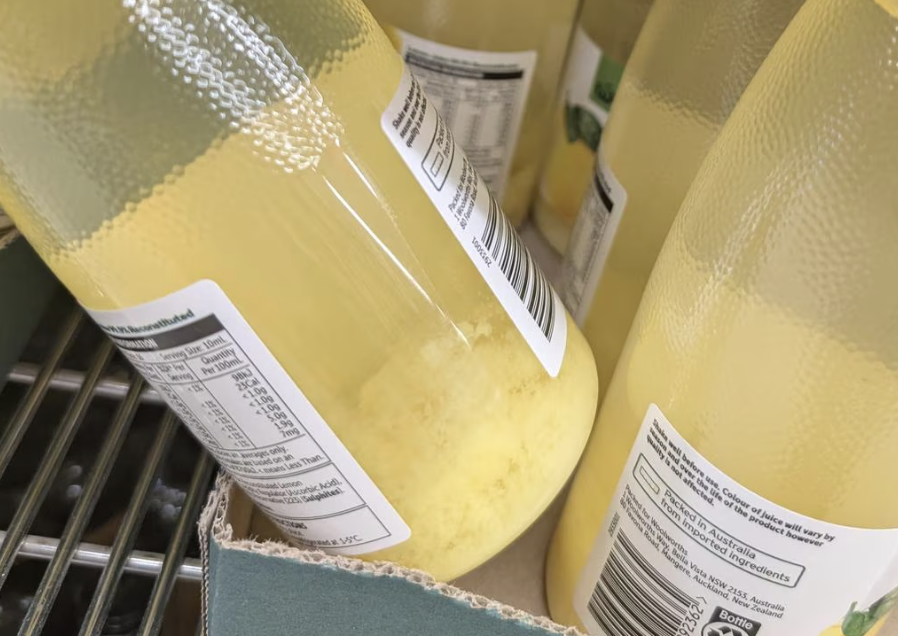
You've reached for your usual bottle of lemon juice at Woolworths, but something's not quite right.
The liquid looks split in two... dark and cloudy at the bottom, clear as water at the top. Your first thought? 'Has it gone off?'
Don't worry, you're not alone. Shoppers across Australia have been scratching their heads over this apparent 'change' to their favourite cooking staple, with many taking to social media to voice their concerns
But here's the thing—this separation isn't a sign of poor quality. It's actually proof you're getting the real deal.
An image of a Woolworths bottle of lemon juice, pictured on a shelf at a store, was posted to social media and caused controversy due to one major detail. The liquid at the bottom appeared dark, while everything floating at the top was almost see-through—not exactly what people picture when it comes to lemon juice.
'What is going on with the lemon juice? Used to be homogeneous, now horrendous,' the image poster ranted. "Didn’t have to shake the sh*t out of it until the brand name stuff disappeared and replaced with Woolworths brand."
Several others joined in, saying the same thing was happening at Coles and ALDI. 'The Coles brand stuff looks like this too. Same s***, different bottle,' one user wrote. Another added: 'ALDI lemon juice is the same, all the sediment sinks to the bottom.'
What's really happening in that bottle
The separation you're seeing is completely natural and occurs because natural fruit juices contain pulp, pectins, and other particles that have different densities from the liquid portion. Think of it like a salad dressing—oil and vinegar naturally separate because they have different weights.
This happens with fresh fruit juice too—when you leave citrus juice long enough, you'll get pulp floating at the top, then also get a watery layer and a cloudier layer. The formation of a pectin-pulp deposit effectively controls the juice's appearance, but it doesn't affect the taste or quality one bit.
'Due to its density, the pulp will settle at the bottom of the bottle over time. A quick shake before use will redistribute the pulp, ensuring the full flavour is enjoyed'
The key point that many shoppers are missing is that Woolworths' lemon juice contains no artificial colours or flavours and retains naturally occurring pulp. This is actually a good thing—it means you're getting a more natural product without artificial stabilizers that would keep everything artificially mixed.
The clear bottle revelation
Here's where it gets interesting. While Woolworths says their formula hasn't changed, Coles has revealed something that explains why more people are noticing this separation now. Coles recently switched to transparent bottles for their lemon juice, making it easier for customers to recycle.
When juice bottles were tinted or opaque, this natural separation was hidden from view. Now that many brands are moving to clear packaging, you can see what's always been happening inside.
It's like suddenly being able to see through your kitchen wall—the house hasn't changed, but now you're aware of what's always been there.
Understanding juice separation science
Natural fruit juice contains particles of different sizes and densities—pulp, pectins, starches, and dissolved solids.
Just like sand settles to the bottom of a jar of water, these heavier particles sink while lighter components float.
The process is called sedimentation, and it's completely normal for any natural product without artificial stabilizers.
What this means for your cooking
For those wondering whether this 'new' lemon juice works the same way in cooking—absolutely. Shoppers report that once shaken, it 'tastes fine' and works perfectly in recipes. The separated juice contains the same acidity levels, vitamin C content, and flavour compounds as before.
In fact, that settled material has a lot of the good flavour compounds in it, so giving it a good shake before use ensures you're getting the full taste experience. Many commercial cold-pressed juices you'll find in cafes have similar separation with instructions to shake before drinking.
The bigger picture: natural vs artificial
This juice situation highlights a broader trend in Australian supermarkets. As consumers increasingly demand fewer artificial ingredients, more products are appearing with natural separation, cloudiness, or colour variations that might look 'wrong' to eyes accustomed to artificially stabilised products.
The loss of juice cloudiness can indicate to consumers that a product is of poor quality, even though pulp sedimentation is natural, and commercial products often develop white sediment during storage. This creates an interesting paradox—natural products can look less 'perfect' than their artificial counterparts.
Making the most of your natural lemon juice
- Always give the bottle a good shake before use
- Store in the refrigerator to slow natural separation
- Don't panic if you see layers—it's completely normal
- The separated juice works just as well in cooking and baking
- Consider this a sign you're getting a more natural product
Storage tips that make a difference
To minimise separation and extend shelf life, store your lemon juice in the coldest part of your fridge. Lower temperatures slow down the natural processes that cause separation, and proper heating during processing (which commercial producers do) helps prevent excessive clarification over time.
If you use lemon juice regularly, consider freezing portions in ice cube trays. One social media user suggested this practical solution, and it works brilliantly—just pop out a cube or two as needed, and you'll always have fresh-tasting lemon juice without worrying about separation.
The recycling win
There's actually a silver lining to this packaging change story. Australian supermarkets are working towards making all packaging recyclable, compostable or reusable, with Woolworths alone removing more than 20,000 tonnes of virgin plastic packaging since 2018.
The move to clear bottles isn't just about transparency in ingredients—it's about transparency in recycling too. In Australia's Container Deposit Schemes, juice bottles under 1 litre are eligible for 10-cent refunds, and clear containers are easier to process through recycling systems.
Did you know?
Did you know?
Western Australia's container deposit scheme has collected more than 4.56 billion containers for recycling, increasing the state's container recovery rate from 34 percent to 65 percent. Your lemon juice bottle could be part of this impressive environmental success story.
When natural looks wrong
This lemon juice confusion reflects a broader issue in food marketing. We've become so accustomed to artificially perfect-looking products that natural variations can seem like defects. Food safety professionals note that precipitation and settling are very common for fruit juices, and this natural process shouldn't cause concern.
Commercial food processors often add stabilizers, emulsifiers, and thickening agents to prevent separation, but these additives aren't necessary for food safety or quality. They're purely cosmetic, designed to meet consumer expectations of how products 'should' look.
The real question isn't whether your lemon juice has changed—it's whether you prefer to see what's happening or have it hidden behind coloured packaging. Most food scientists would argue that transparency, both literal and figurative, is better for consumers.
Looking ahead
As Australian supermarkets continue improving their environmental credentials and reducing artificial additives, expect to see more products with natural variations. The Australian Government's 2025 National Packaging Targets are pushing retailers towards more recyclable materials, which often means clearer, simpler packaging.
This shift represents a win-win situation—better environmental outcomes and more natural products. The trade-off is getting used to seeing natural food processes that were previously hidden.
What This Means For You
So next time you spot that separated lemon juice at Woolies, give it a good shake and know you're supporting both environmental sustainability and natural food production. Your pavlova will taste just as good, and you'll be doing your bit for the planet too.
What's your take on this lemon juice situation? Have you noticed similar changes in other products, or do you prefer the natural approach even if it looks different? Share your thoughts—we'd love to hear how you're adapting to these more natural products in the comments below.
Original Article
https://www.news.com.au/lifestyle/f...n/news-story/9c7e222f81c0cb71a98dea9bf1bf05c8
Separation of aromatics compounds during the clarification of lemon juice by cross-flow filtration—ScienceDirect
Cited text: The existing traditional methods for clarification of fruit juices are slow and inconsistent for lemon juice due to haze and sediment formation which ...
Excerpt: The separation you're seeing is completely natural and occurs because natural fruit juices contain pulp, pectins, and other particles that have different densities from the liquid portion
https://www.sciencedirect.com/science/article/abs/pii/S0926669011004407
Juice Vesicles—an overview | ScienceDirect Topics
Cited text: Without heat stabilization to inactivate pectinesterase enzyme, clarification or loss of cloud may occur in single-strength orange juice due to the se...
Excerpt: The separation you're seeing is completely natural and occurs because natural fruit juices contain pulp, pectins, and other particles that have different densities from the liquid portion
https://www.sciencedirect.com/topics/agricultural-and-biological-sciences/juice-vesicles
juicing—What is the white sediment / residue found in ginger juice? - Seasoned Advice
Cited text: This happens with fruit juice, too.Fresh fruit juice separates and needs to be shaken to get things reincorporated. If you leave citrus juice long eno...
Excerpt: This happens with fresh fruit juice too—when you leave citrus juice long enough, you'll get pulp floating at the top, then also get a watery layer and a cloudier layer
https://cooking.stackexchange.com/q...-white-sediment-residue-found-in-ginger-juice
The use of membrane processes in the clarification of orange and lemon juices—ScienceDirect
Cited text: These results are due to the formation of a pectin-pulp deposit on the membrane, which effectively controls the ultrafiltration.
Excerpt: The formation of a pectin-pulp deposit effectively controls the juice's appearance
https://www.sciencedirect.com/science/article/abs/pii/0260877494900671
juicing—What is the white sediment / residue found in ginger juice? - Seasoned Advice
Cited text: However, that white stuff has a lot of the good yummy gingerness in it, so I would want to make sure it got stirred into anything I made with my ginge...
Excerpt: that settled material has a lot of the good flavour compounds in it
https://cooking.stackexchange.com/q...-white-sediment-residue-found-in-ginger-juice
Effect of hydrocolloids on pulp sediment, white sediment, turbidity and viscosity of reconstituted carrot juice—ScienceDirect
Cited text: In general, the loss of juice cloudiness resulted from the pulp sedimentation. However, apart from pulp sediment (PS), the occurrence of white sedimen...
Excerpt: The loss of juice cloudiness can indicate to consumers that a product is of poor quality, even though pulp sedimentation is natural, and commercial products often develop white sediment during storage
https://www.sciencedirect.com/science/article/abs/pii/S0268005X06000336
Juice Vesicles—an overview | ScienceDirect Topics
Cited text: They found that, at their natural pH, the heating required to prevent clarification was more drastic for orange and grapefruit than for lemon. The dif...
Excerpt: Lower temperatures slow down the natural processes that cause separation, and proper heating during processing (which commercial producers do) helps prevent excessive clarification over time
https://www.sciencedirect.com/topics/agricultural-and-biological-sciences/juice-vesicles
Juice Vesicles—an overview | ScienceDirect Topics
Cited text: The authors concluded that the clarifying enzymes were more heat resistant at high pH. At any rate, heating at 90°C for 1 min was sufficient for preve...
Excerpt: Lower temperatures slow down the natural processes that cause separation, and proper heating during processing (which commercial producers do) helps prevent excessive clarification over time
https://www.sciencedirect.com/topics/agricultural-and-biological-sciences/juice-vesicles
Sustainable packaging
Cited text: Woolworths Group is working towards transitioning our own brand ranges to recyclable, compostable or reusable packaging. As of July 2025, we have remo...
Excerpt: Australian supermarkets are working towards making all packaging recyclable, compostable or reusable, with Woolworths alone removing more than 20,000 tonnes of virgin plastic packaging since 2018
https://www.woolworthsgroup.com.au/...ainability/Product/sustainable-packaging.html
Sustainable packaging
Cited text: Promoting recycling, including displaying the Australasian Recycling Label (ARL)* on 100 per cent of own brand product packaging in our supermarkets and BIG W...
Excerpt: Australian supermarkets are working towards making all packaging recyclable, compostable or reusable, with Woolworths alone removing more than 20,000 tonnes of virgin plastic packaging since 2018
https://www.woolworthsgroup.com.au/...ainability/Product/sustainable-packaging.html
Victoria‘s Container Deposit Scheme | Find Eligible Containers
Cited text: Most fruit and vegetable juice bottles, cans and cartons between 150 ml and 1 Litre are eligible.
Excerpt: In Australia's Container Deposit Schemes, juice bottles under 1 litre are eligible for 10-cent refunds
https://cdsvic.org.au/eligible-containers
What you can return | Return and Earn—Bottle, Can & Container Recycling—Official Site
Cited text: water, soft drink, flavoured milk under 1L, juice and sports drinks · Glass bottles ie. water, beer, soft drink, pre-mixed spirits, juice and kombucha...
Excerpt: In Australia's Container Deposit Schemes, juice bottles under 1 litre are eligible for 10-cent refunds
https://returnandearn.org.au/what-you-can-return
Container deposit scheme | Western Australian Government
Cited text: The success of the scheme to date rests on more than 4.56 billion containers collected for recycling and diverted from landfill. This translates to th...
Excerpt: Western Australia's container deposit scheme has collected more than 4.56 billion containers for recycling, increasing the state's container recovery rate from 34 percent to 65 percent
https://www.wa.gov.au/service/build...ces/waste-management/container-deposit-scheme
Precipitation/residues/sedimentation in pasteurized fruit juices—IFSQN
Cited text: We receiving complaints of having precipitation, residues forming at the bottom of the bottle, which is we very common for fruit juices to settle pulp...
Excerpt: Food safety professionals note that precipitation and settling are very common for fruit juices, and this natural process shouldn't cause concern
https://www.ifsqn.com/forum/index.p...uessedimentation-in-pasteurized-fruit-juices/
Sustainable packaging
Cited text: The Guidelines provide a helpful tool as we work towards phasing out the hardest to recycle materials from all packaging by 2025 in line with the Aust...
Excerpt: The Australian Government's 2025 National Packaging Targets are pushing retailers towards more recyclable materials
https://www.woolworthsgroup.com.au/...ainability/Product/sustainable-packaging.html
Sustainable packaging
Cited text: ‘Green’ = packaging materials and characteristics which are widely recyclable in Australia and New Zealand.
Excerpt: The Australian Government's 2025 National Packaging Targets are pushing retailers towards more recyclable materials
https://www.woolworthsgroup.com.au/...ainability/Product/sustainable-packaging.html







